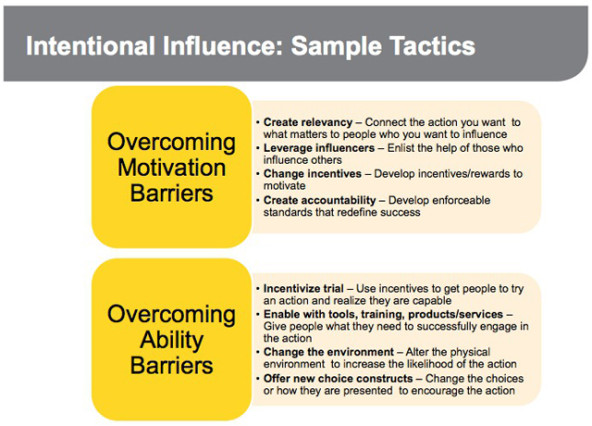The path to solving complex social problems such as childhood hunger or the high school dropout crisis is not an easy one. And while influence is one of the most powerful tools available to us, we don’t see many organizations applying it intentionally. Jeff Bradach's recent article, "Transformative Scale: The Future of Growing What Works," articulates a variety of strategies for solving large-scale problems, including recruiting and training other organizations, and changing public systems. Not surprisingly, influencing people underpins most of these approaches, highlighting the importance of intentional influence in transformational strategy.
Intentional influence involves committing to a more holistic approach—seeing the big picture, transcending silos between related issue areas, and persuading expanding groups of stakeholders to see the connection between the problem we seek to solve and their own values and priorities. Often, widening our circle requires that we let go of ownership, credit, preconceived ideas, and “business as usual.” It also requires that we empathize with those we seek to influence and resist the temptation to assume that what moves us will move them.

In practice, intentional influence is a process. Leveraging influence with intentionality entails determining who can play a role in solving the problem and what actions we want them to take (do we want them to change their behavior? make a decision? commit resources?), as well as understanding their unique perspectives. In our work with nonprofits and foundations, we've identified a few questions that can help guide organizations through this process, and uncover the people, assets, and approaches that can bring about positive change.
Five Questions
1. Understanding stakeholders: Who can help solve this problem, and where do we begin?
It is helpful to begin with a comprehensive mapping of all who have a role—the interest and/or power—in solving the problem. Since very few problems exist in a vacuum, we find that it’s valuable to cast a wide net that includes both likely and unlikely groups. Recognizing the connections between these groups can provide an opportunity to see how those working on related issues can advocate for your work, and you for theirs.
At the same time, anyone working on social problems is all too aware that you can't tackle everything at once. Also, most people want assurance that an effort is worthwhile and feasible before they jump on board. When prioritizing stakeholders to approach, consider starting with:
- Individuals who can help you achieve early wins to prove that the work is worthwhile,
- Individuals who can influence a significant number of people, and/or
- Individuals who can influence people who are essential to progress.
2. Understanding assets: What can we leverage to move others to act?
Once an organization understands its universe of stakeholders, it should evaluate and map its own assets—things it has, does, and knows. Relationships, credibility, knowledge, stories, and data are just a few of the tools we can use to influence others’ behavior and decisions. Often, it requires that we use many assets at once. To wring every ounce of value out of intentional influence efforts, examine all of the assets at your disposal, determine how to maximize them, and address any gaps.
3. Identifying desired actions: What action do we want others to take?
To solve a problem at the magnitude it exists, we often need to pursue change at three levels: personal, organizational, and systemic. Every level starts with people, so it’s important to determine the most important behaviors or actions we want different groups to take.
An individual may act to change their own behavior (a student may attend school, for example), an organization’s policies or procedures (a hospital administrator may adapt an internal process), or an entire public system (a congress member may vote for a policy change). The bigger challenge is uncovering why someone isn’t taking the action we want them to take.
4. Understanding barriers: What stands in the way of people taking the action we desire?
While identifying desired actions is fundamental to intentional influence, empathizing with and understanding stakeholders’ beliefs and the context in which they operate is equally—if not more—valuable. The work of identifying and overcoming barriers begins with putting ourselves in their shoes, developing hypotheses about why they aren’t taking the action, and testing what works. The book Influencer: The Power to Change Anything asserts that for people to engage in a behavior, they have to believe that it is worth it and that they can do it. This framework provides a starting point for thinking about what the barrier to action might be—a lack of motivation or ability—and how to overcome it.
5. Designing an approach: How do we move people to take the action we desire?
Once we understand what’s missing from the motivation-ability equation, then it’s time to select and test an approach to overcome that barrier. To overcome a lack of motivation, organizations might consider making the action more relevant by reframing it, leveraging existing influencers (such as peers), or changing incentives or disincentives. To overcome a lack of ability, organizations might enable action through tools and/or training, or by changing the physical environment and/or available choices for engaging in the desired behavior. Social scientist BJ Fogg asserts that a trigger—a cue that tells people to take the action now—is also important for moving someone to action. When designing an approach it can be helpful to evaluate the relevancy of a trigger to moving a particular group to action.
 Our experience with social sector organizations and a review of books like Influencer: The Power to Change Anything and articles like "Harnessing the Science of Persuasion" inspired these tactics.
Our experience with social sector organizations and a review of books like Influencer: The Power to Change Anything and articles like "Harnessing the Science of Persuasion" inspired these tactics.
While these questions are simple, we recognize that answering them can be complex and may require specialized expertise, ranging from behavioral economics to advocacy. But as we seek to solve large-scale problems, we have to remember that ultimately social change requires that we influence the behaviors and decisions of many people. We will only be successful if we can clearly articulate the actions we need people to take, and intentionally design approaches that motivate and enable them to move.
Support SSIR’s coverage of cross-sector solutions to global challenges.
Help us further the reach of innovative ideas. Donate today.
Read more stories by Sara Brenner & Amy Celep.

